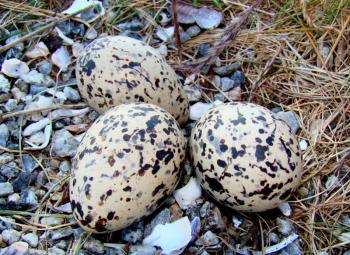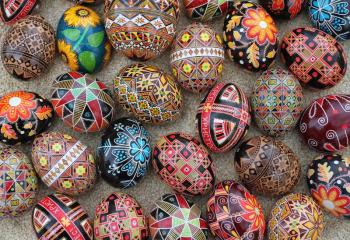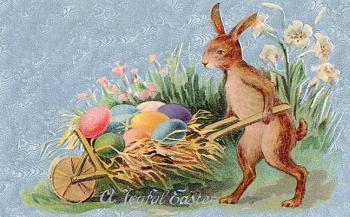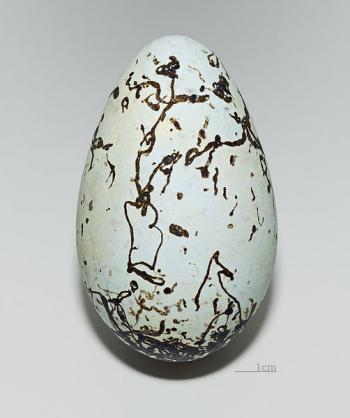In J.R.R. Tolkien's The Hobbit, Bilbo Baggins gets into a riddle competition with Gollum in their first fateful meeting. One of Bilbo's riddles is this:
A box without hinges, key, or lid,
Yet golden treasure inside is hid.
The answer—an egg—is easy for Gollum, who loves to suck "eggses."
For those who celebrate Easter, much of the holiday's symbolism is focused on the egg. We eat candy eggs, decorate real eggs, hide eggs, stage egg hunts to find them, and compete in egg-rolling contests. For Christians, the egg is said to be a symbol of Christ's resurrection.
But as with many Christian holy-days, Easter has some deeper, pagan roots that tap into a cross-cultural recognition of the egg as a fertility symbol. It thus makes perfect sense that the ever-fecund rabbit—another, easily recognizable fertility symbol—would be delivering eggs during this most fertile and sexy season of the year, in the guise of the Easter Bunny.
Religion aside, the egg is truly a miracle of creation. From the proteins and chemicals in her own body, a bird creates this amazing container for her chick: a hard-shelled but breathable "box" that also holds the "golden treasure" of all the nutrients that the chick will need to survive in there. Once this container has left her body, she then incubates it, keeping it warm and safe in a nest until the chick hatches. This evolutionary development has worked well for birds for millions of years. When you hold a fertilized egg in your hand, you're holding a living calcium carbonate gem.
I have strong tactile memories from childhood of reaching under my grandmother's hens to find those perfect, smooth, warm eggs. There's something soothing about holding an egg, the way it fits in the palm. As with chicken eggs, many eggs are ovoid to prevent them from easily rolling away. For seabirds like the Common Murre, a puffin relative that nests on rocky cliffs on offshore islands, the eggs are downright pointed so that if bumped they'll spin in a circle and not into the ocean. Certainly not an egg you want to use in your egg-rolling contest. Birds that nest in tree cavities, however, such as Saw-whet Owls or woodpeckers, lay eggs that are almost round; even if they roll around, those eggs aren't going anywhere.
Producing an egg is not a simple process. It takes about 24 hours. The fertilized ovum is, at first, just the yolk. In the oviduct, the gelatinous egg white, almost pure protein, forms around the yolk. Then a membrane grows around the yolk and white to contain them. Calcium carbonate is then secreted onto this membrane from special glands, forming the shell. Pigmentation—color and/or pattern—is then added on top of the shell in the last hours of its making, the glands acting as ink jets. Before being ejected from the bird, the egg receives a final protein coat, as well.
Almost all birds have the ability (if not the genetic programming) to produce two different egg pigments, one reddish-brown and the other blue-green. Variations of these two pigments create the wide variety of color and pattern found in bird eggs today, including the famous "robin's egg blue." If you could only use two colors to decorate your Easter eggs, odds are that you would come up with far fewer variations on color and theme than a bird.
I've often come across pieces of robin eggshell on the sidewalk, easily recognizable by that pretty blue color. Why eggs are different colors is still being understood. One line of thought is that the intensity of color potentially indicates the health of the mother bird, although it has also been observed that eggs within a clutch can vary significantly in color.
An interesting recent study found that bluer eggs, like those typically produced by robins and other tree-nesting species, better deflect harmful UV rays. But darker eggs also absorb more light and thus warm up faster, which can harm the developing embryo. So a more complex mechanism is thought to determine egg color on a continuum from white to blue, with sun exposure being the primary variable. Birds that nest in dark tree cavities usually lay white eggs, for example.
An excellent source of protein, eggs are a sought-after wild food. Thus, many species' eggs are colored and patterned in such a way as to camouflage them from predators' eyes. The eggs of the Common Grackle, for example, laid in a mud-lined nest, are covered with brown blotches. The eggs of Peregrine Falcons, which are often laid on ledges, are brown and heavily speckled as if with dirt, which would certainly make them less visible from above. Birds that lay their eggs in ground depressions, such as the terns that nest on Maine's seabird islands or Wild Turkeys, also produce heavily patterned eggs.
Some researchers theorize that unique pigmentation patterns on eggs may also help birds that live in large, open colonies, such as Razorbills, identify their own eggs when returning from sea. Others theorize that distinct colors and patterns help some bird species distinguish their eggs from those of nest parasites, such as the Brown-headed Cowbird, which lay their eggs in other birds' nests. A cowbird chick can hog all the food and even knock other nestlings out of the nest. So it's beneficial for parent birds to be able to pick out and eject cowbird eggs. There are so many aspects of the natural world that we are just beginning to understand.
It's also worth noting that many types of bird, including most songbirds, can see ultraviolet light. What are they seeing when they look at their own eggs? How does UV light interact with the natural pigmentation of the eggs, and what can it tell the parent birds? For all we know, some birds' eggs might look like pysanka, those beautifully decorated Ukrainian Easter eggs. But unlike those artful eggs, to the birds it's what's on the inside that really counts.
Kristen Lindquist is an amateur naturalist and published poet who lives in her hometown of Camden.





























